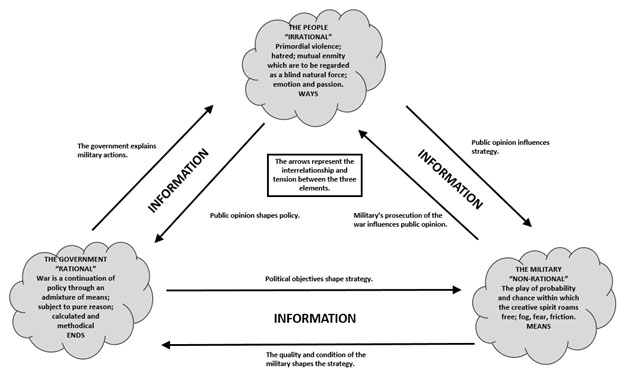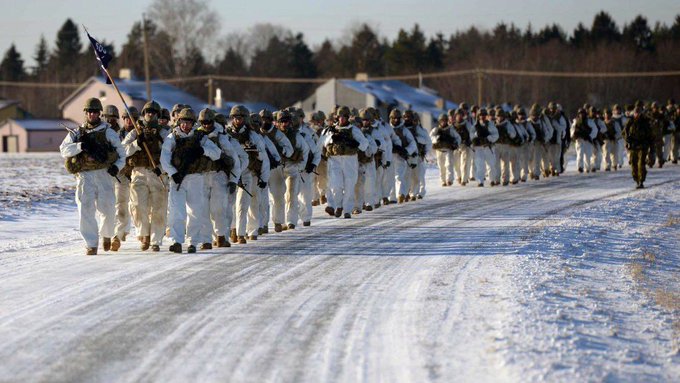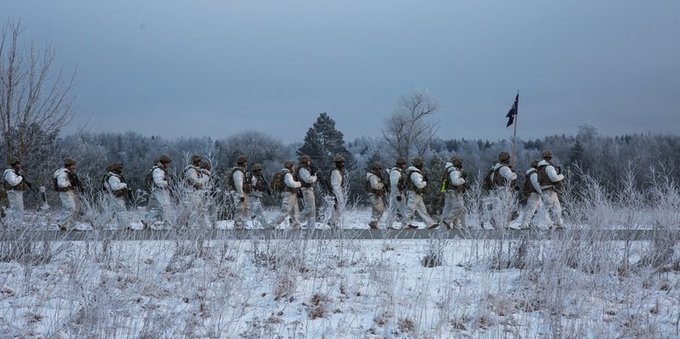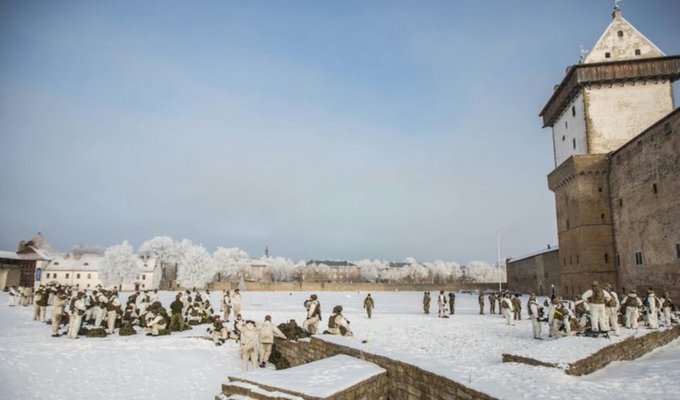For links see article source.....
Posted for fair use.....
http://smallwarsjournal.com/jrnl/art/innovation-of-military-thought-in-the-postmodern-warfare-era
Innovation of Military Thought in the Postmodern Warfare Era
by Larry Kay
Journal Article | February 2, 2017 - 11:27am
Key Points
- Contemporary Russian political-military doctrine was on full display in 2016 US elections.
- Effective disinformation campaign rebuts Clausewitz’s trinity by severing the dialectic interrelationship between the government, the people and the military.
- Postmodern warfare is multi-domain, borderless competition dominated by the ability of state and non-state actors to manipulate information through metanarratives to decisively overwhelm or undermine adversaries, focusing on non-combatants for sources of internal and adversarial political dissidence.
- The United States military urgently requires an innovation of military thought and a new theory that incorporates the dynamics of the postmodern environment.
Introduction
As I watched the inaugural celebration, I reflected on Toby Keith’s Courtesy of the Red, White and Blue, “A mighty sucker punch came flying from somewhere in the back”, and then asked the question, How did the Russians achieve strategic surprise and how did we fail to anticipate the Russian attack on our democracy and our political sovereignty? Keith’s lyrics refer specifically to the 9/11 attacks, but if you think about it in terms of US vital interests (territorial integrity and political sovereignty), both 9/11 and Russia’s recent meddling in our political system represent attacks on the United States’ two vital interests, yet both yielded dramatically different results. As evidenced by Russia’s recent strategic success, the United States urgently needs a new all-encompassing theory of warfare in pursuit of future national security objectives because the current American theory of warfare is quickly becoming inadequate. Importantly, this essay does take as both reliable and accurate the National Intelligence Council’s assessment and analysis of Russia’s activities and intentions in recent US Elections.
According to the findings of the intelligence assessment provided by the National Intelligence Council, which speaks for the entire community of all 17 intelligence agencies, the Russians actively perpetrated a disinformation campaign against the US election. To summarize the essence of the report: “Russia’s goals were to undermine public faith in the US democratic process, denigrate Secretary Clinton, and harm her electability and potential presidency.” The Central Intelligence Agency (CIA), Federal Bureau of Investigation (FBI), and National Security Agency (NSA) assess further the “Russian Government aspired to help President-elect Trump’s election chances when possible by discrediting Secretary Clinton and publicly contrasting her unfavorably to him.” It is here we are provided with the what, “influence of the presidential election,” and the why, to undermine the American political system and help President-elect Trump win the election.1
Although this instance of Russian meddling is a significant escalation, it is not a new Russian strategy. It started during World War II (dezinformatsiya: disinformation) and continued during the Cold War. Then, it reemerged in Estonia in 2007, evolving with an integrated kinetic information operation in Georgia in 2008 and Ukraine in 2014, Montenegro in 2016, and in the 2016 US presidential election. There are reliable reports indicating that the Russians are meddling in the upcoming French, Dutch and German elections, as well.2 By every measure, Russia has mastered the art of information dominance, disinformation campaigning, and irregular warfare. And, by deliberately targeting the US electorate, Russia has credibly influenced and induced the United States population to unknowingly act how they would not have otherwise acted. Unfortunately, it is difficult for populations targeted by an effective and large-scale disinformation campaign to reasonably assert that they were not influenced to some degree. Like deterrence, it is unmeasurable – it is difficult for an individual to determine what information (stories, facts, narratives etc.) and to what extent that information did or did not influence their opinion of the world.
*
And, why should they not pursue this type of strategy? It is cheap, difficult to attribute, and has been highly effective. In fact, Russia has modernized their strategy commensurate to the pervasive influence information technology and social media have in today’s world. As it so happens, on February 26, 2013, the Chief of the Russian General Staff, General Valery Gerasimov published “The Value of Science is in the Foresight:* New Challenges Demand Rethinking the Forms and Methods of Carrying out Combat Operations.” General Gerasimov published this article in the Russian Journal, Military – Industrial Kurier, and it expresses clearly his view of the operational environment. Below are some of the key insights:
- Recent history illustrates that a perfectly thriving state can, in a matter of months and even days, be transformed into an arena of fierce armed conflict.
- The very “rules of war” have changed. The role of nonmilitary means in achieving political and strategic goals have grown, and in many cases, they have exceeded the power of force of weapons in their effectiveness.
- The focus of applied methods of conflict has altered in the direction of the broad use of political, economic, informational, humanitarian, and other nonmilitary measures – applied in coordination with the protest potential of the population.
- New information technologies have enabled significant reductions in the spatial, temporal and informational gaps between forces and control organs. Frontal engagements of large formations of forces at the strategic and operational level are gradually becoming a thing of the past. Long-distance, contactless actions against the enemy are becoming the main means of achieving operational goals. The defeat of the enemy’s objectives is conducted through the entire depth of his territory.
- The importance of military science, which must create a comprehensive theory of such actions, is growing.3
This article presaged the aggressive annexation of Crimea in 2014 and more recently the meddling in US elections. Interestingly, in his role as the Chief of General Staff, General Gerasimov executes operational control of the Glavnoye Razvedyatel’noye Upravleniye, or the GRU, which was one of the organizations named as responsible for cyber operations aimed at US political officials. This Russian intelligence agency’s efforts sought to compromise politicians’ personal email accounts through extensive spear-phishing.4 All of this suggests that the Russians have developed a new theory of warfare, and in the future, we can only expect them to perform it more effectively and on an even larger scale. The expectation that adversaries will follow suit is a foregone conclusion.
The Predominant & Competitive Theories
What is theory? What is the American theory of warfare? Basing the answer on what the US Army Command and General Staff College teaches, there are two predominant and competitive theories of warfare:* Antoine-Henri Jomini and Carl von Clausewitz. Each have their merits, and the supporters of either side may make valid arguments, but they do so in vain. Like organizing the lounge chairs on the Titanic, they are engaging in a debate that bears little relevance on today’s postmodern battlefield, and bears even less relevance on future warfare. Written at the dawn of the industrial revolution, both of these theorists established the foundation for modern warfare and strategy on a linear battlefield. And, up until now, both theories guided generations of military officers and national security specialists through challenging problems at every echelon and level. Coincidentally, their contributions shaped modern warfare, which involves heterogeneous, organized, mutual enmity and violence between armed groups, on more than a minor scale, carried out with political objectives, possessing socio-political dynamics, and focused on the exerting of power in order to compel opponents. Modern warfare appeared in the post-French Revolutionary era of nationalism, during which the interwoven dynamics of national community, struggle, and power have determined a particular form of violent conflict.5
To review some theory behind modern warfare, 9/11 is a prime example of Clausewitz’ remarkable Trinity. The country was attacked, both the people and the government demanded a response, the government developed a response, the people supported it and the military executed it. These circumstances allowed the United States to lead a coalition to war in Afghanistan with the explicit objective of destroying al-Qaeda and ousting the Taliban regime that harbored them. It all made sense from a Clausewitzian theoretical perspective.
http://smallwarsjournal.com/sites/default/files/larrykay1.jpg
Now, the United States must address Russia’s interference its other vital US national interest: *our political sovereignty. We have yet to develop a conceptual response for this type of assault. Additionally, the American public is confused and divided, unaware which information to interpret as true and reliable. Of supreme importance is that many of the organizations responsible for developing a response are also paralyzed with confusion, due to the effectiveness of the Russian attack on our political system. More than that, however, was the effect the Russian attack had on the way we view warfare. Ultimately, the relative information dominance the Russians achieved through their extensive and far-reaching disinformation campaign essentially distorted the interrelationship between the three pillars of Clausewitz’ trinity. Moreover, the Russian doctrine studied the dynamic interaction between the pillars, attacking the informational interaction or “information space” between the three pillars. Consequently, there was a time when this model was proper and now is the proper time for us to think about a new theory of warfare, which includes all of the complex dynamics that affect society since the late 20th century—economics, trade, cyberspace, global communications, global terrorism, space, climate change, human terrain etc. Of note, a curious takeaway from General Gerasimov’s article is his visualization of the postmodern battlefield. General Gerasimov asserts information technology eliminates the distinction traditionally afforded to notions of tactical, operational, and strategic levels of war.6
Theory
“In all affairs, it’s a healthy thing now and then to hang a question mark on the things you have long taken for granted. Many people would sooner die than think. In fact, they do.”
*********** ************************************************************************************** -- Bertrand Russell7
Interestingly, Clausewitz’ theory will remain helpful to understand warfare, especially at the ground level for the soldier, but it needs an update and the US needs an evolution of military and security policy thought to account for all of the changes brought about by modernization, and now postmodernization. Thankfully, this is where the study of theory can help us evolve military thought. The intent is not to eliminate the profound impact Jomini and Clausewitz had on warfare and international relations, but to build upon their efforts and genius to improve our emerging policy going forward. For better or for worse, it is engrained in military culture to accept what is provided, and this includes the acceptance of a theory of warfare. Naturally, a good deal of hostility to a new theory will no doubt come from the fact that to admit the importance and need for a new theory is to admit error and to seek improvement.8 This alone may be considered as an unacceptable predicament or condition in national security circles. However, theory is often an incisive critique of common-sense notions and practices, and further, an attempt to reconsider the past’s certainties as today’s assumptions. More importantly, to trust in theory is to admit that common sense accepted practices are in fact a historical construction, both time-dependent and circumstantial.9
Yet, the military insists upon imprinting Clausewitzian theory on the postmodern landscape. To truly evolve, we must question the most basic premises and assumptions of our environment – to unsettle anything that might have been taken for granted or previously disregarded.10 Perhaps, even the word “warfare” itself incorrectly frames the problem, and may ultimately be an imperceptible source of apprehension from interagency partners who would prefer not to engage in “warfare”. Moreover, this false logocentric confidence in the word “warfare” as the representation of a policy may be an illusion – the meaning of the word influences the structure of reality itself and hence makes the truth about that structure, and purpose of that structure, actually subjective.11 Too, the semantic debate between irregular, unconventional and hybrid warfare dominates discussions more than the doctrines’ effects on an environment. Perhaps, as well, the predominance of gray zones further indicates our conceptual inadequacy with postmodern warfare; we just cannot wrap our minds around them.12 Regardless, whatever theory is proposed, the conceptual effort must originate from the entire joint enterprise—from every organization in the United States government, to include the private sector, whose goal it is to pursue national security and American interests the world over. Unified action and multi-domain battle are a great concepts, but are just not enough.
In addition, this new evolution in military thought could build conceptual bridges between our domestic policy and our foreign policy. Potentially, this new theory could marry national security with national prosperity; and could see the instruments of national power keenly blended to maximum effect and employed in correct interaction with each other so as to bring out their advantages and mask their weaknesses.13 This new theory could incorporate Western military thought, Eastern military thought, and military thought of countries south of the equator—a blend of every culture and generation that has something useful to provide. Further still, the new military thought can continue to revel the innovations of the past, while looking intently at the future. Do we really expect that our way of warfare will be applicable one, two, or even three hundred years from now? This innovation of military thought might be the optimistic post-mortem analysis the United States military needs. In light of all of this, my hypothesis is that postmodern warfare is multi-domain, borderless competition dominated by the ability of state and non-state actors to manipulate information through metanarratives to decisively overwhelm or undermine adversaries, focusing on non-combatants for sources of internal and adversarial political dissidence. Postmodern warfare began in the late 20th century, when the internet and therefore the ability to influence populations, changed the nature of strategic access. Open access to the world-wide web initially provides parity to all actors in the information environment. Unlike industrial modern warfare, postmodern warfare is driven by information technology.
Where to begin?
“In the councils of government, we must guard against the acquisition of unwarranted influence, whether sought or unsought, by the military–industrial complex.”
*********** ******************************************************* -- President Dwight D. Eisenhower14
Every few years, talk of military growth erupts and new weapons and equipment are the first choice for modernization and innovation. Surely, there are parts of the defense department that have outpaced the technical modernization of others; there is a clear asymmetry. However, rarely does the civilian government involve itself with global force management except for appropriations and authorizations when it comes to the size of the army or the materiel within it—where the money is. Recently, stock values for defense contractors have soared:* Lockheed Martin – up 4.8%; Northrop Grumman – up 5.1%; General Dynamics – up 4.1%; L-3 Communications – up 5.4%; Textron – 2.2%; Boeing – up 0.76%; and Huntington Ingalls 6.5%.15 This is worrisome because it signals that innovation of thought to win on the battlefield of tomorrow’s ideas will be eclipsed by yesterday’s weapons. Yet, this strategic bewilderment currently dominates and colors the realities of today’s security environment. For example, the internet became widespread in the 1990s, with nearly every global bank, large corporation and developed country completely relying upon it for daily business. To this day, however, we struggle to modernize our protection mechanisms commensurate with the advanced threats posed to it, instead opting to buy more of yesterday’s jets, the past’s tanks and history’s naval vessels – relics of the last century’s modern warfare. Clearly, these weapons retain their purpose in the pursuit of American national security objectives, but it seems that our adversaries have subdued their ultimate utility by changing the context in which war is fought through information. While our technocratic predilections served us well in the past, and will continue to serve a purpose in the future, it is merely an ingredient, a singular element of a larger and necessary innovation. Maybe an adjustment to our capabilities gap assessment could include theory as an essential precursor? Theory drives all of it:* the doctrine, the organizations, the training, the materiel procurement, the leader development, the personnel, the facilities, and the policy.
Why the Urgency?
Alarmingly, General Gerasimov astutely described that a country’s protest potential can accelerate the rate of change a country experiences. “Recent history illustrates that a perfectly thriving state can, in a matter of months and even days, be transformed into an arena of fierce armed conflict.”16 Unfortunately, this phenomenon is not isolated, signaling an even more worrisome condition: the liberal world order that arose from the rubble of World War II is currently under siege, and the rising regional powers are positioning themselves to gain regional preeminence. The tectonic plates of geopolitics are shifting before our eyes, and not subtly either. We cannot return to the past and erase the effect Russian disinformation operations. However, we can still make strategic gains.
http://smallwarsjournal.com/sites/default/files/larrykay2.jpg
Above:* Social media post about the humanitarian assistance Russia provided to the people of Aleppo
“Soft” and “smart power”, again, are on the tip of many experts’ tongues. In international politics, having power is having the ability to influence another to act in ways that entity would not have acted otherwise.17 Hard power is the capacity to coerce them to do so. In contrast to hard coercive power, soft power is the capacity to persuade others to do what one wants; and is measured by a country’s values, culture and foreign policy.18 In academic writing, it is the neorealist approaches that tend to emphasize hard power, especially the hard power of states, while other scholars emphasize soft power as an essential resource of statecraft. Above all, the greatest benefit of soft power is the power to write the rules of the game or reframe the paradigm of the international order.19 This is Russia’s aim. The big why, or the expanded purpose that evaded the common national discourse in the aftermath of the political election is made hauntingly more relevant when you place Russia’s subsequent actions in strategic context. The deliberate combination and strategy of simultaneous foreign intervention, humanitarian relief, disinformation campaigning targeted at the US, paralyzing the UN Security council by vote, and forming an entente with Turkey and Iran over the future of Syria brings new credibility to Russia. It’s only a matter of time before our leverage and influence in regions and domains we have enjoyed supremacy are challenged. An essential prelude to our conceptualization of a new theory is to ask first, however, a generational question:* what do we want our role in the world to be?
Where Do We Go From Here?
Sadly, these strategic challenges do not stop with Russia. Non-state actors, like the Islamic State of Iraq and the Levant (ISIL), can achieve a relative advantage in the information environment. According to a November, 2015 US State Department study, nearly one in three Iraqis believed that the United States directly supports ISIL.20 This is troublesome. Needless to say, the world is complex, dynamic and turbulent, a perpetual whitewater rapids of sorts. Recently, a mentor of mine suggested that we are always one miscalculation away from a limited nuclear war. Furthermore, the United States military and its interagency partners must always be prepared to engage in sustained, multi-domain conflict—this is our solemn oath to the American people. Unfortunately, the postmodern battlefield does not eliminate the need to consider either of these horrors. However, providing for the common defense innovating military thought and evolving for future defense are not mutually exclusive. If adapting to wartime conditions is desperately difficult, those involved in interwar innovation will confront almost insoluble problems:* it is here that the leaders of military institutions and inter-agencies will earn their pay.21 In the near future, below are some areas for future study and inquiry:
- The United States could embark upon a revolution in military affairs (RMA) that accounts for the seemingly endless complexity in postmodern “warfare”.
- Global disinformation operations targeting entire populations, combatants and non-combatants alike, are fundamentally un-American. However, the United States could devise new methods of achieving strategic information dominance.
- Considering that Russia’s RMA deliberately targeted the United States population, domestic policy and national security should be more closely wedded than ever before. The United States is not an autocracy, so this will take time, but for the better. Though, how do we counter the threat of disinformation operations without undercutting domestic policy?
- In this strategic context, perhaps the study of postmodern “warfare” could help neutralize the threat of “lone-wolf” attacks inspired by internet-spread propaganda.
Until the geopolitical tectonic plates stop shifting, the United States military and its interagency partners should pause to critically and contextually think about the future and to develop a new theory of warfare, of security, of prosperity and of influence that is appropriate for the postmodern era.
The views and opinions expressed in this article are those of the author, and do not represent the policies or the positions of the United States Army, the United States Department of Defense or any agency of the United States government.
End Notes
1. Office of the Director of National Intelligence. (2017). Intelligence Community Assessment:* Assessing Russian Activities and Intentions in Recent US Elections, p. ii.
2. Huggler, Justin. (2017). Russia is Targeting French, Dutch and German Elections with Fake News. The Telegraph. January 24, 2017.
http://www.telegraph.co.uk/news/201...g-european-elections-fake-news-eu-task-force/
3. Gerasimov, Valery. (2013). The Value of Science is in the Foresight:* New Challenges Demand Rethinking the Forms and Methods of Carrying Out Combat Operations,” trans. Robert Coalson, Military-Industrial Kurier, 27 February 2013.
4. Bartles, Charles K. (2016). Getting Gerasimov Right. Military Review, January-February, 2016, p. 1.
5. English, Richard. (2013). Modern War:* A Very Short Introduction. Oxford University Press, 2013. Great Clarendon Street, Oxford, OX2 6DP, United Kingdom.
6. Gerasimov, Valery.
7. Russell, Bertrand.
8. Culler, Jonathan. (1997). Literary Theory:* A Very Short Introduction. Oxford University Press, 1997. Great Clarendon Street, Oxford, OX2 6DP, United Kingdom, p. 16.
9. Ibid.
10. Ibid.
11. Butler, Christopher. (2002). Postmodernism:* A Very Short Introduction. Oxford University Press, 2002. Great Clarendon Street, Oxford, OX2 6DP, United Kingdom, p. 17.
12. Kay, Larry. (2016). Managing Gray Zones is a Gray Matter Challenge. Small Wars Journal. 27 July 2016.
http://smallwarsjournal.com/jrnl/art/managing-the-gray-zone-is-a-gray-matter-challenge
13. Crevald, Martin Van. (2000). The Art of War:* War and Military Thought. Smithsonian Books, 2000. HarperCollins Publishers, 10 East 53rd Street, new York, NY 10022, p. 35.
14. Eisenhower, Dwight D. (1961). President Eisenhower’s Farewell Address, January, 17 1961.
15. Cohen, Stanley. (2017). From War to More War.*
http://www.aljazeera.com/indepth/opinion/2017/01/trump-inherit-obama-war-legacy-170123115134240.html
16. Gerasimov, Valery.
17. Wilson, Ernest J., III. (2008). Hard Power, Soft Power, Smart Power. Annals of the American Academy of Political and Social Science, Vol 616, Public Diplomacy in a Changing World, p. 114.
18. Keohane, Robert and Nye, Joseph. (2012). Power and Interdependence. Pearson Education, Inc., p 216.
19. Wilson, p. 114.
20. Ferran, Lee. (2016). One Third of Iraqis Think US Supports Terrorism, ISIS.
http://abcnews.go.com/International/iraqis-us-supports-terrorism-isis/story?id=38220207
21. Knox, MacGregor and Murray, Williamson. (2001). “The Dynamics of Military Revolution:* 1300 – 2050.” New York:* Cambridge University Press.
About the Author
Larry Kay
Major Larry Kay is currently a student at the US Army Command and General Staff College. His last assignment was as the Deputy Chief of Staff of the 4th Infantry Division's Mission Command Element forward in Germany in support of Atlantic Resolve. His previous assignments were as Commander of both A Co and HHC, 4-9 IN, 1SBCT, 4ID. MAJ Larry Kay is also a Strategic Studies Fellow with the University of North Carolina Chapel Hill's Institute of Defense and Business.
-
Comments
Add New Comment
by Tom Triumph | February 4, 2017 - 1:05pm
Login or register to post comments
The article was interesting.
While modernizing foundational philosophies is always important, I wonder under which department such a "force" might fall under? Much of this seems to fall under the auspices of civilian intelligence agencies. Should it? If this is more of a military operation, does a recalibration of civilian and military roles need to happen? Where do roles fall? Our military has more accountability, and act more accountable, than many black agencies.
Are these roles defensive or offensive in nature? Offensive assaults have never sat comfortable with many Americans (nor should it, beyond promoting our brand or as a step prior to military action). And what does a defensive position even look like? With the Russians painting Clinton unfavorably to Trump, wouldn't government interference be seen as (or be) mixing politics with policy?
Besides restoring our civilian intelligence agencies to their original goal of gathering intelligence, we can best protect ourselves by:
Transparency: When the truth is readily available it is more difficult to put out false information that sticks. While it cannot combat some false stories, American citizens get a vast amount of information from the government. Being able to access meeting minutes, data collected or policy statements eases fears.
Trust: The more transparency there is, the great trust in the government there is. So, when an agency posts numbers or offers warnings, Americans will take notice.
Politicians have to trust the people, too. More and more, it seems, politicians are trying to control the democratic landscape for electoral gain. That ranges from gerrymandering districts to monkeying with voting access to passing legislation in the wee hours of night. While they might have our "best interests at heart" transparency allows citizens to judge for themselves.
Our greatest threat, though, is from politicians sowing fear for gain. Unfortunately, our new president seems to be the new practitioner. Had the White House, for example, posted Trump's executive order "banning Muslims" after signing, the uncertainty of the order would have been less. Instead, it was a weekend of chaos and uncertainty for citizens. Never mind the fact that he did not go through the normal channels of the Justice Department or Homeland Security to check process or Constitutionality, the order is questionably effective in its stated goals.
Media and Civic Literacy: NCLB is a noble law, but the focus on literacy and math has taken away from the teaching of civics and history. Rightly, students are learning more world history, but that should be in addition to U.S. history and, of course, civics. Instead, they get less.
Media is now king, yet schools do little to teach how to use it. Besides the dangers of the internet, students Google anything and take the first answer as gospel. While my generation learned to search for information in the absence of it, this generation needs to learn to sift the wheat from the chaff. That is our best line of defense.
Of course, those two go together: Being able to search and judge information, and having that honest information available.
But the last pillar is standing for something. We have moved from a nation that passes laws to one that files lawsuits. As a lefty liberal, I urge lawmakers to pass a law reaffirming a woman's right to choose. Why? Because it being handed down by law rankles all of these decades later. Compare that to Brown vs. the Board of Education; although it, too, was a landmark case, the 1963 Civil Rights Act and subsequent legislation came from democratically elected representatives, putting such issues (largely) to rest.
As Americans, we need to decide what our ideals mean, and reaffirm our willingness to pay the costs that come with them.

























